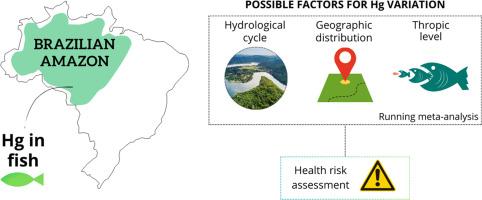Total mercury and methylmercury levels in Brazilian Amazon fish: A scope review with meta-analysis and local population health risk assessment
引用次数: 0
Abstract
Introduction
The Brazilian Amazon has one of the richest biomes and the largest source of freshwater on the planet. However, anthropogenic activities have also turned this region into one of the highest points of human exposure to mercury ever recorded. Therefore, the aim of the present work was to perform a scope review with meta-analysis in order to evaluate the total mercury (THg) and methylmercury (MeHg) levels in Brazilian Amazon fish, as well as to carry out a local population health risk assessment.
Methods
A literature search was systematically performed in research databases and gray literature, remaining 14 studies from 2017 to 2022 for final analysis. The studies were submitted to raw mean and subgroup meta-analysis, followed by a risk characterization and the calculation of a maximum safe consumption of fish for the Amazonian population.
Results
The selected studies covered 4 Amazonian states, as well as included the analysis of >30 fish species of different trophic levels and sampling in >15 cities. The overall total mercury mean obtained for Brazilian Amazon fish was 0.29 ug g⁻¹. Significant difference was observed between THg levels according to fish trophic level (p < 0.05), which reinforces the MeHg biomagnification. When THg levels from all fish samples were pooled, it was not observed a significant difference among the Amazonian states and the fish sampling season. However, significant variations between microregions and species-specific variations over the seasons should not be discarded. All estimated daily methylmercury intake exceeded the reference dose of 0.1 ug kg BW⁻¹ day⁻¹, resulting in a hazard quotient (HQ) greater than 1 and indicating a risk of chronic exposure by the local population. The maximum safe consumption of fish calculated based on the overall total mercury mean was set as 31, 147 and 173 g week⁻¹ for children, adult women and adult men, respectively, which is much lower than the reality of consumption by the riverside communities (2870 g week⁻¹).
Conclusion
There is an urgent need to reduce Hg exposure levels in the region as well as to recommend other protective nutritional strategies to the local population such as defining the fish species with lower mercury contamination levels and their safe weekly consumption.

巴西亚马逊鱼类中的总汞和甲基汞含量:通过荟萃分析和当地人口健康风险评估进行范围审查
导言巴西亚马逊拥有地球上最丰富的生物群落和最大的淡水资源。然而,人类活动也使该地区成为有记录以来人类接触汞最多的地区之一。因此,本研究旨在通过荟萃分析进行范围综述,以评估巴西亚马逊鱼类中的总汞(THg)和甲基汞(MeHg)水平,并对当地人群进行健康风险评估。对这些研究进行了原始平均值和亚组荟萃分析,随后进行了风险特征描述,并计算出亚马孙地区人口食用鱼类的最大安全摄入量。巴西亚马逊鱼类的总汞平均值为 0.29 微克/克-¹。根据鱼类营养级的不同,总汞水平之间存在显著差异(p <0.05),这加强了甲基汞的生物放大作用。将所有鱼类样本的三卤甲烷含量汇总后,发现亚马逊各州和鱼类采样季节之间并无显著差异。不过,也不能排除不同微区之间的明显差异以及不同季节不同物种之间的差异。所有估计的甲基汞日摄入量都超过了 0.1 微克千克体重-¹日-¹的参考剂量,导致危害商数(HQ)大于 1,表明当地居民有长期接触甲基汞的风险。根据总汞平均值计算出的儿童、成年女性和成年男性的鱼类最大安全食用量分别为每周¹31克、147克和173克,远低于河流沿岸社区的实际食用量(每周¹2870克)。
本文章由计算机程序翻译,如有差异,请以英文原文为准。
求助全文
约1分钟内获得全文
求助全文
来源期刊

Journal of trace elements and minerals
Medicine and Dentistry (General), Analytical Chemistry, Environmental Science (General), Toxicology, Biochemistry, Genetics and Molecular Biology (General), Nutrition, Veterinary Science and Veterinary Medicine (General)
自引率
0.00%
发文量
0
审稿时长
65 days
 求助内容:
求助内容: 应助结果提醒方式:
应助结果提醒方式:


